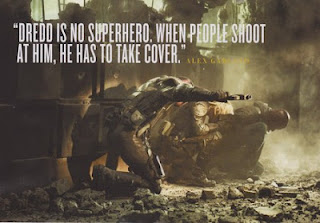Background:
It's 3Defence's mission to chronicle the development of 3D Cinema. Dredd arrives at an interesting time in the medium's modern history: ultra-violent, reverent to the comics it's based on, filmed in native-3D on location in South Africa... it's hardly 'the norm' amongst 3D films in 2012. To make things even more interesting: Dredd was written by Alex Garland, who is fast becoming the 'go-to' writer for dark and semi-believable takes on near-apocalyptic sci-fi tales. Dredd is also probably the most kick-ass English language action film to come out along in a long time. But... how good is the 3D?Native 3D:
The majority of the film was shot using Paradise FX rigs, on location and in sets in South Africa's Johannesburg and Cape Town. Digital extensions were used to transform the city into the post-nuclear-war landscape of Mega-City One, but the original footage was seamlessly integrated into this sprawling urban chaos. In charge of the filming was Anthony Dod Mantle; responsible for the stylised look of films like 28 Days Later, Slumdog Millionaire and The Last King of Scotland. If anyone knows his way around a digital rig, it's going to be Dod Mantle. One gets the impression with Dredd that the idea was to take as much stereoscopic information in as possible, and then use various post-production methods to 'enhance' the experience in every way possible.Does the 3D 'pop'?
Damn right it does. It's the most 'invasive' 3D we've seen in a live-action film in a very long time. A key plot point of the film revolves around a drug called, imaginatively enough, "slo-mo". The drug makes its participants see the world in a euphoric haze of smoke, stars, and ultra high-definition slow motion footage. Overdone at first, and then used for good reasons later, the shots where we 'see' the effects of the drug remind the viewer of other highly stylised action flicks like The Matrix and 300. While it's not done often, the 3D effects extend beyond the screen and seem to travel through the theatre towards the audience - usually while someone's blood is being splattered behind them. If that's not enough (and really, with Dredd, over-the-top is the preference) the film's hero is paired up with a psychic, who can see people's thoughts in a vivid, and surreal, view that also sends visible shock-waves outwards from the big screen.How's the depth of the 3D?
Tell you what, watch the video below to find out! It shows you how they extended the sprawl of South Africa "into infinity":What they don't show you in that clip though, is how often you end up staring down the centre of these cavernous towers, looking down from the top floor through to the lobby below. These gigantic buildings can become tombs when protective blast doors shut around them, effectively trapping the occupants inside. These massive objects quickly take on a claustrophobic quality, despite their hulking size. There's a scene where a character is outside one, looking out across the city, and the loneliness they feel is made palpable by the height and distance of these structures from one another. They may be able to see the world around them, but they are completely and devastatingly alone, separated by hundreds of meters from outside assistance. In sum then? The depth is fantastic, when it needs to be.








Hi purchased Dredd today. I am a 3d enthusiast love to watch 3d films in its depth and crispiness.what about the latest 3d films after 2014?
ReplyDelete